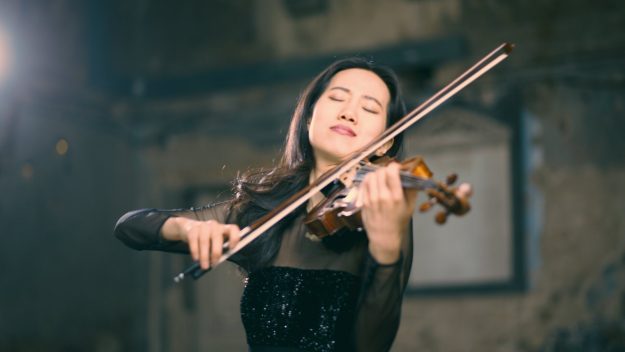 United Kingdom Bernstein, Prokofiev, Bax: Joo Yeon Sir (violin), Northampton Symphony Orchestra / John Gibbons (conductor). Christ Church, Northampton, 2.3.2024. (RBa)
United Kingdom Bernstein, Prokofiev, Bax: Joo Yeon Sir (violin), Northampton Symphony Orchestra / John Gibbons (conductor). Christ Church, Northampton, 2.3.2024. (RBa)

Bernstein – Symphonic Dances from West Side Story
Prokofiev – Violin Concerto No.2
Bax – Symphony No.1
Latter-day fashion has been close to unmerciful about Bax. Yet even after the deaths of Handley/Del Mar/Thomson/Leppard/Downes – a group by no means homogeneous – he still has a few champions: John Gibbons, John Wilson (performing all three of big-name tone poems plus the recently played Spring Fire, review here) and, in Sheffield, Jose Ortuna.
Over the years, I had in my diary treks to Northampton for several of the annual Malcolm Arnold festivals. The composer’s birthplace sports an heroic large portrait banner-poster at the railway station. It gleefully proclaims Arnold’s local (and national) eminence, although its strapline sells him short: it only notes the light music and film scores.
Tonight’s concert of orchestral music filled the main body of Northampton’s CofE Christ Church. There were no empty seats. The church has just sufficient room for a large orchestra and, let us say, 500 members of the audience.
Conductor John Gibbons has given many concerts over the years (Worthing, Ealing and St John’s Smith Square, to name a few), and his programmes are never hackneyed. He is now in the process of performing all George Lloyd’s twelve symphonies. He is also busy recording for Toccata Classics the orchestral music of William Wordsworth; the Sixth Symphony is perhaps on the cards, at last. He is ever the staunch supporter and risk-taker, and the scores he lights on are often not fashionably acceptable. His 2019 British Music Society gala concert (review here) with the Ealing Symphony Orchestra was a no-holds-barred treat, and a platform for the music of Carwithen, Harty, Alwyn and Bax (Symphony No.1).
As is Gibbons’s custom, he addressed the Northampton audience before each piece. I might not have always agreed with his biographical interpretations and with relating music to current-day events, but he has a very engaging manner. I rather like his quiet yet telling delivery, even more so when he makes recommendations, as he did for last year’s Bernstein biopic Maestro.
Bernstein’s Symphonic Dances would have been a challenge for any orchestra. There were moments where everything was happening at once – the ecclesiastical acoustic clouded the sound then. Gibbons in his intro played up the gangland crash and fizz but played down the romance. Certainly, the dances favoured the clash of arms and the rejection of conventionality. Yet for me the enchantment came in the three poetic sections with violins led by Emily Groom. The violin tone was creamily rich and delightfully heartwarming. For all the pizzazz, crash and shouts from the orchestral players (like Delius’s Eventyr but more chaotically dissolute), it is to the great credit of Bernstein and Gibbons that the work ended not with a bang but a whimper; and it was a whimper of courageous serenity.
The violinist Joo Yeon Sir was new to me. I like Prokofiev’s Second Violin Concerto less than the First, but the soloist’s rapt confidence won me over, and left me in wonder, especially at the middle movement. I felt that the music in outer movements was less than this artist merited. Ah, that Andante assai! It was miraculously projected, and the soloist was – in sound, manner, tone and presence – every bit the haughty, but not bombastic, aristocrat. She is another Oistrakh or Kogan in terms of her memorably flawless accomplishment and full-on projection. That central movement, complete with its Bachian arioso and superb legato, made me hark back to the masterly storytelling of the First Concerto, written some two decades earlier.
After the interval came Bax’s First Symphony from 1921-1923. Like all his numbered symphonies, it has three movements. He wrote for a big and often burly orchestra. Because of the flat plain seating, I could not see everything, but there were two harps, contrabassoon, bass clarinet, a full wind and string complement, and a crowd of percussion players. Bax’s orchestration here had moved on from Spring Fire (which extraordinarily I had heard in Salford only ten days before). There was a measure of clarity in the sound, but this was a crowded acoustic experience, with ‘the clouds magically parting’ from time to time.
The first movement is a big statement gripped and shaken by conflict. I am not sure about parallels with the First World War and with the Irish rebellion. Even so, at an essential level this work feels, even today, like a statement about horror and ignorant armies clashing by night. In the manner of his String Quartet No.1 and Piano Quintet, towards the end of that first movement Bax comes away with one of his superbly enchanting melodies couched in perfectly weighted orchestration.
The pellucidly scored slow movement, which Gibbons described as film music before Hollywood, seemed to speak of strange realms; at one point it was surely influenced by Holst’s Saturn. The finale gathered itself up to march brusquely forward in a world of Russian nationalist sound alla Rimsky-Korsakov. The brass section rejoiced, as did the percussion. Celebratory but blood-thirsty corteges are the order of the day, with half an eye cast over the shoulder haunted by a reminiscence of desperation.
I hope Gibbons will let us hear more Bax symphonies (and perhaps Moeran’s Symphony in G minor). I know that he has a full score and complete set of orchestral parts for the Fourth Symphony, even though my first choices would be Symphonies Two, Five and Six.
Rob Barnett
